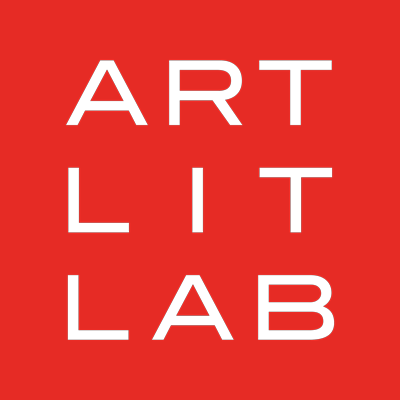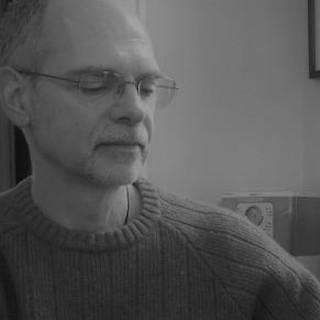It is not uncommon to transform grief through creativity. When someone passes, we write obituaries and assemble collages of photographs and videos. With diverse, personalized, kaleidoscopic quilt panels, The NAMES Project (the National AIDS Memorial) became and remains an expansive testament honoring those whose lives were taken by AIDS. In Aesthetics of Loss, the current installation at Arts + Literature Laboratory, eight artists harness this transformational phenomenon by sharing with us their journeys through personal experiences of grief.
Several of the artists were also caregivers for the people they pay tribute to. During an artists’ talk facilitated by Adrienne Kochmann (Ukrainian Institute of Modern Art) they discussed the transference and implementation of caregiving in the creation of their artworks. Anders Zanichkowksy, who weaves burial shrouds, and whose Burial Blanket for Merle Geode is on display, equated the repetition involved in caregiving tasks with the repeated steps in weaving: “when I sit at the loom and I’m throwing the shuttle and I’m pulling the beater and my feet are working the treadles, the loom becomes an extension of my own consciousness and my own body….”
Linda Marcus’s multi-media pieces, Untitled aka Rock Hard I and II, consider the caregiver’s difficulties when traveling longer distances to help a loved one. Worn clothing is stretched over large rectangular surfaces and lacquered with black car paint. Harsh, yellow bands of acrylic divide the surfaces like fog lines on an asphalt highway.
Both the caregiver’s and care receiver’s faces are turned away from us in Anticipatory / Después, a haunting and poignant photo series by Brianna Hernández. In “Para Mi Para Ti,” we observe the caregiver kneeling outside a bathtub and washing the care receiver’s feet and legs. Light enters the room through what appears to be a frosted glass window and seems to flare on an embroidered flower curtain in the spot where the care receiver’s face would be, if it were visible. In “Espérate,” we glimpse the caregiver’s vigil for the receiver who lies in bed surrounded by candles and fading flowers. The window in the background, revealing a deep, blue sky and shadowy tree branches, contrasts a small mirror to its left, illuminated with an ethereal golden white light.
The passing of artist EBTI’s father is called out by his absence from a triptych of fabric (photographic) prints entitled You Can Rest Now—Baba’s Chairs. If viewed from left to right, we first imagine him seated on a balcony, in a solid, wooden chair, perhaps taken from a dining room table. Next, we see an ergonomic office chair augmented with cushions and a neck pad. Last is a wingback armchair cushioned by a brightly striped throw pillow and draped with a cloth that seems wrinkled from body heat. The person not seen in these chairs may be depicted by EBTI’s conceptual sculpture Still Light, in which stringed lightbulbs hanging upon a coat rack are like a near-skeletal human figure.
This piece dovetails with Jaymee Harvey Willms’s Busted, Still Lit Tho and “What a Disaster?” two of several mixed media pieces, employing broken lamps and home decor items, ceramic figurines, bistro chair legs, and “Fragile” tape. The characters lying within these sculptures are profoundly affecting, whether they are a menagerie of rabbits huddling in the wings to a reluctantly paternal duck (Swaddled) or a wobbling, three-legged, winged gnome crowned with a frosted glass lamp shade (I Got This).
Turning to aspects of the survivor’s experience are three paintings by Cassidy Early. In Rest, a gray cat lies curled up on the heart of a character lying supine among dandelions and napping peacefully, perhaps after an ordeal symbolized by a flock of surreal crows. The other paintings, Another Life, Another Ghost and A Useful Template for Summoning the Dead employ a yellow, ruled motif suggested by the legal pads Early’s mother used “to write as many notes to us as she could…” after being diagnosed with cancer.
Similarly, Nirmal Raja’s father, who died suddenly in 2020, left behind his final thoughts in handwritten lists, poems, and pages filled with the transcription of chants. My Father’s Journal transfers this content to custom printed fabric which become pillow slips. Three of these are selected as cushions for three porcelain dipped shirts (Material Remains—Shirts 1, 2, and 3). When discussing the development of these pieces, Raja likened clothing to a second skin and drew a parallel from the process of glazing and firing her father’s shirts to his cremation. She said, “(it’s) impossible to disassociate garments from the body and witnessing my dad’s cremation was very transformative.” Raja further reflected on the things we leave behind when we die: “What do you do with all that stuff? How do you hold onto those stories, those impressions, the imprints of someone’s life on others.”
Indeed, when we die, our things must go somewhere. Our clothing, our furniture, our dining and kitchen items can all be donated. Our digital footprints, we hope, will be handled by some responsible person. But if we were creative during our lives, what happens to our sketches, our paint brushes, our digital photos, our blogs, our paper journals, our expensive fountain pens and unused cartridges of ink, our musical instruments, our audio and video recordings?
Like Raja, Jessica Meuninck-Ganger explores things left behind. Magpie, a series of nine ink and graphite screen prints, reimagines her mother’s snow globe collection by replacing the contents with other, treasured objects, such as a pair of ice skates attributed to Sonja Henie, a bearded court jester, and a character who resembles Mr. Spacely from The Jetsons, cruising in a flying vehicle. In Val’s Transparent Gloss the artist applies replicas of her father’s sculpting tools on three-dimensional screen prints backed with foam board that resemble window shutters of sections of a dock. The pieces are arranged on a the gallery wall from eye level to ceiling. The artist states that they cascade, though they may also be seen as ascending.
The pieces in Aesthetics of Loss flow together brilliantly in the ALL Galleries. At times it feels like they are conversing, sharing memories, comforting, and inviting us to connect with them. The artists who have contributed to this installation remind us of the power and necessity of art in times of suffering and crisis. We are indebted to them.

